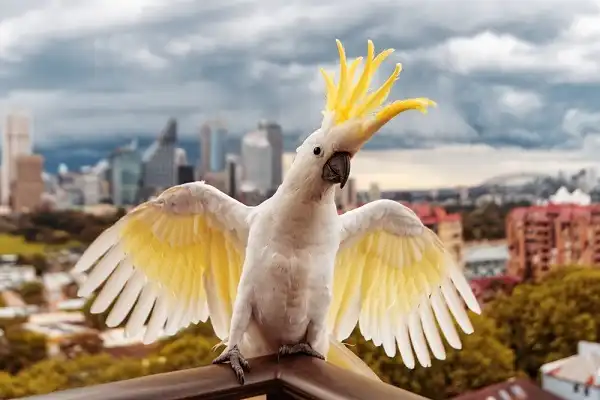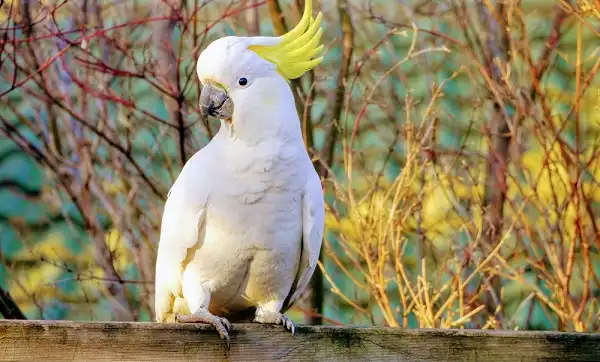Picking the perfect pet can be a tricky task to undertake. Some people opt for traditional four-legged furry friends while others choose something more exotic, like a parrot — or even, dare I say it, a Cockatoo! These birds are known for their signature crest feathers and friendly personalities, making them an ideal choice for those looking for an avian companion that stands out from the pack. With proper care and attention, this regal bird can become your newest family member and delight you with its wonderful personality traits. Read on to learn more about Cockatoos including their interesting behavior habits, dietary requirements, and how best to welcome one into your home!

Cockatoo Description
Cockatoos are medium-sized parrots that are easily recognizable by their signature crest of feathers. These birds can be found in various colors including white, yellow, black, gray, and pink. Their body shape is also quite distinct with a broad head, short hooked bill, and a long tail. The crest feathers of a Cockatoo can be moved independently and often stand on end when the bird is excited or feeling threatened. Cockatoos have a broad head and short hooked bill which distinguishes them from other parrot species. They also possess a unique crest of feathers that stands up when they are excited or feeling threatened. This helps them to appear larger when needed as a form of protection against predators. Cockatoos also have long tails which can be used for balance while jumping or flying.
Cockatoo Habitat
Cockatoos are native to Australia and some parts of Indonesia, and can be found in both tropical rainforests and dry woodlands. They primarily nest in tree hollows where they can feel safe and secure from predators. Cockatoos also enjoy roosting on branches or in the canopy of tall trees. In captivity, Cockatoos need a spacious enclosure with plenty of room to move around and explore. The enclosure should include perches at different heights to encourage natural climbing behavior. Additionally, the space should provide plenty of natural sunlight as well as play areas such as swings or ladders that allow them to engage in stimulating activities throughout the day.
Cockatoos are also known to be quite messy eaters so their enclosures need to be cleaned regularly and deep-cleaned every few weeks. A variety of bird-safe toys should also be provided within the enclosure as this helps keep your pet stimulated and prevent boredom-related behaviors such as feather-plucking or screaming excessively. With proper care and attention, your Cockatoo can become a beloved member of your family!
Cockatoo Diet
Cockatoos need a balanced diet of fresh fruits, vegetables, seeds, and nuts. This means providing them with an assortment of foods from all four food groups in order to ensure that they get the nutrients they need. Fruits and vegetables should make up around 40% of a Cockatoo’s diet while seeds and nuts should make up the remaining 60%. It’s important to avoid feeding Cockatoos processed or sugary snacks as these can lead to health problems such as obesity and malnutrition. Additionally, Cockatoos should not be given avocado, chocolate, or caffeine as these can cause serious illnesses. It’s also recommended to avoid feeding wild-caught prey items like insects or rodents due to the potential for introducing parasites into their system. In addition to providing a balanced diet, it’s also important to provide your Cockatoo with plenty of fresh water throughout the day. Additionally, you can supplement their diet with vitamins and minerals if needed; this is best done under the guidance of an avian veterinarian.

Cockatoo Size
Cockatoos are medium-sized parrots, typically measuring between 12 and 24 inches (30 to 60 cm) in length from head to tail. They usually weigh between 8 and 22 ounces (227 to 624 gm), although some larger species may reach up to 3 pounds (1.4 kg). Cockatoos come in a variety of colors including white, yellow, black, gray, and pink. Their size can vary depending on the species; for example, the Moluccan Cockatoo grows much larger than its Sulphur-crested cousin.
Cockatoo Lifespan
Cockatoos are long-lived birds with lifespans of up to 80 years. This is largely dependent on the species, as well as their living conditions. In terms of wild cockatoos, they can live for around 30 years, while captive cockatoos can survive for up to 80 years. This is due to the fact that owners can provide them with the proper care and nutrition necessary for a longer lifespan. Typically, smaller species such as Moluccan Cockatoos have shorter lifespans compared to larger species like Sulphur-crested Cockatoos. These birds may also live longer if they are provided with plenty of space and activities within their enclosures. Additionally, providing your feathered friend with a balanced diet full of vitamins and minerals helps ensure they receive all the necessary nutrients for a healthy lifespan.
Cockatoo Behavior
Cockatoos are highly intelligent birds with a range of behaviors, both in the wild and in captivity. They are social animals that form strong bonds with their owners and flockmates and can show signs of affection such as preening to each other. Cockatoos are also known to be good problem solvers, creating puzzles for themselves by manipulating objects or using items like sticks to open doors or acquire food. In terms of vocalizations, Cockatoos are quite vocal creatures and have been known to mimic human speech. Some species can even use words they’ve heard just once!
Vocalizations can range from loud screeches or screams to soft purring sounds when content and happy. Additionally, Cockatoos may also display behaviors such as swaying side-to-side while making noise or bobbing their heads while singing songs. While cockatoos possess many positive traits, they can become bored easily if not given enough stimulation. This is why it’s important to provide them with plenty of bird-safe toys within their enclosures in order to keep them busy throughout the day. Furthermore, it’s important to establish a regular routine as this will help your feathered friend feel secure and comfortable in its environment.

Cockatoo Speed
Cockatoos are surprisingly agile birds, with the ability to fly, climb and jump through obstacles with relative ease. In terms of speed, they can reach up to 30 miles per hour (48 km/h) when in flight and are capable of sustained flight for several hours. Cockatoos also have excellent maneuverability due to their long wingspan and wide tails that help them change direction quickly in mid-air. When climbing, Cockatoos are just as impressive; they can ascend trees or branches with remarkable agility, often able to reach heights of up to 10 meters (33 feet). They use their powerful claws to cling to surfaces while their thick feathers provide warmth and insulation against the elements. In terms of running, Cockatoos move much slower compared to their flying speed, typically reaching speeds of around 2 miles per hour (3.2 km/h). This makes them relatively slow-moving land creatures although they are still able to outrun most predators if necessary!
Cockatoo Common Health Issues
Cockatoo’s common health issues are primarily related to diet and environment. Poor nutrition, inadequate housing, and a lack of stimulation are the most common causes of illness in cockatoos. Malnutrition is especially common amongst those not fed a regular, balanced diet that includes all the vitamins and minerals they need. Additionally, overcrowding or unsanitary living conditions can increase stress levels in birds and lead to infection or other illnesses. In addition to environmental factors, cockatoos can suffer from certain genetic disorders such as feather cysts, which cause bald patches on their bodies; Psittacine Beak and Feather Disease (PBFD), an infectious disease that affects the development of feathers; or Proventricular Dilatation Disease (PDD), a progressive neurological disorder that affects the digestive system. Regular veterinary checkups can help identify these issues early on, allowing for proper treatment and management. Finally, it’s important to note that cockatoos are also vulnerable to parasites such as mites or lice which can cause skin irritation or infestations of feathers if left untreated. Maintaining good cage hygiene is key to preventing these pests from settling in your pet’s habitat.
Cockatoo Hunting
Cockatoo hunting is a practice that has been in existence for centuries, with the birds being highly sought-after as prey. They are considered to be ideal games due to their size, intelligence, and speed. In some parts of the world, cockatoos are still hunted for food or sport. In terms of methods used for hunting cockatoos, they can be shot from the ground or sky using shotguns or rifles; nets can also be used to capture them in mid-air. Trapping is also popular amongst hunters since it requires less skill and preparation than other types of bird hunting. It involves setting out baited traps on the ground that lure the birds in where they are then captured alive and released once their captors have had their fill of avian meat or feathers. In general, cockatoo hunting is considered to be very difficult since these birds are incredibly wary and alert, often perching at great heights or fleeing quickly when disturbed by predators. Furthermore, since most species of cockatoos are listed as threatened due to habitat loss or poaching, many countries have put strict regulations in place regarding their capture or sale which must be followed by all hunters.

Conclusion
Cockatoos are intelligent and highly social parrots that make wonderful companions for those who can give them the love, attention, and stimulation they need. They possess a wide range of vocalizations, behaviors, and physical abilities that make them unique among birds. These birds thrive when given plenty of mental stimulation through toys or training sessions as well as physical exercise in the form of supervised outdoor visits. When it comes to common health issues related to cockatoos, inadequate nutrition or environment can lead to various types of illness if left untreated; regular vet checkups should be done in order to detect any issues early on. Finally, hunting these birds is very difficult due to their intelligence and speed making regulations regarding capture or sale very important
Frequently Asked Question


